The 30 Most Impressive Science Fair Projects In The Country
Eitan Acks created the "Tongue Untwister" to treat speech impediments.

Aakshi Agarwal designed potential drugs that could treat rheumatoid arthritis.
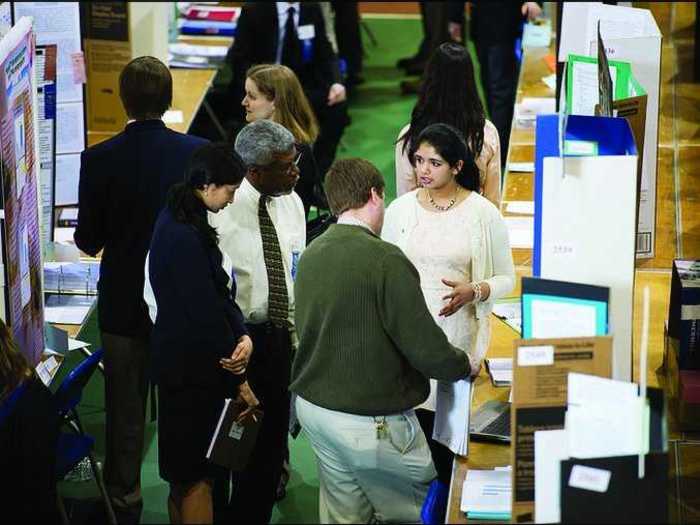
When Aakshi Agarwal, 14, volunteered in a nursing home she developed relationships with many people suffering from rheumatoid arthritis. Her experience inspired her research into TNF-alpha: the molecule that contributes to the painful inflammation of the disease.
Using a computer program, Agarwal designed 200 drugs that could potentially treat this inflammation by inhibiting the enzyme TACE that produces TNF-alpha. Agarwal hopes to actually create and test her new drugs once she is older.
Agarwal's future career interest is the following: neuroanatomy.
Sidhika Balachandar tested the effectiveness of soundproofing materials.
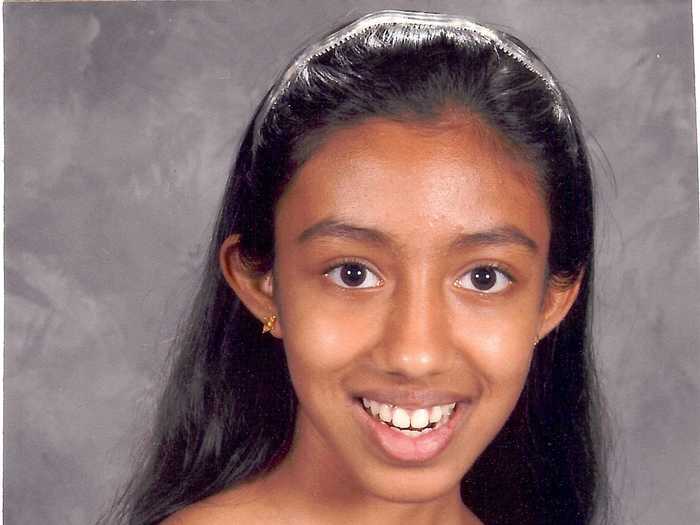
Sidhika Balachandar, 13, designed a set of experiments to determine the best material for soundproofing her mother's home office. Balachandar put a speaker in a cardboard box, wrapped in various materials and measured the volume outside of the box with a sound meter.
She wanted to see if a decorative material could work as well as professional-grade soundproofing material, so her mother's office could be soundproof, but still look nice. She found that soundproofing roof tile worked best, but was closely followed by a double layer of tapestry.
Balachandar's future career interest is the following: engineering.
Drew Becker tagged and tracked harmful fracking fluids.
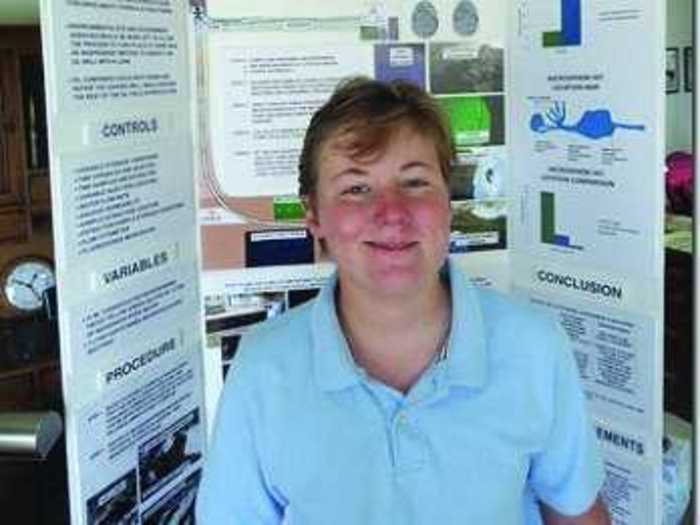
Drew Becker, 13, created a way to monitor potentially harmful natural gas leaks that fracking can cause. These leaks can contaminate the groundwater near fracking sites. Becker sent small amounts of two types of stained bacteria down part of the Popo Agie River in Wyoming.
The stretch of river he tested runs underground through a water reservoir, and Becker found his tagged bacteria in a pool downstream where the river reappears above ground — meaning they successfully flowed downriver, even underground.
Becker's future career interest is the following: commercial diving.
Michael Becker investigated how cold weather affects instrument pitch.
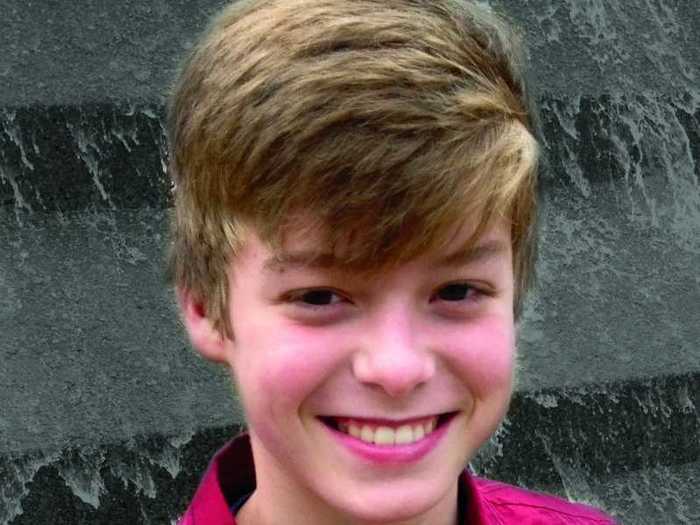
Michael Becker, 14, noticed that his school band did not sound quite on pitch when they played during cold weather football games. He decided to test a brass, woodwind, string, and electronic instrument and measure the effect changes in temperature had on their pitches.
For each test, he left the tuned instrument outside so it could adjust to the temperature, and then measured its pitch. Becker found that the brass instrument sounded flat in colder weather, and the string instrument sounded sharp.
Becker's future career interest is the following: accounting.
Rebecca Bloomfield tested treatment methods for burned and blackened soil.
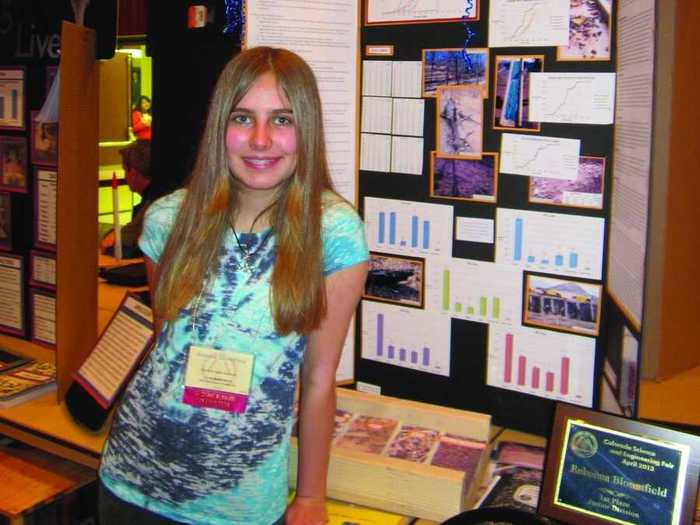
Rebecca Bloomfield, 14, found the best cover material to keep blackened soil from washing away. Bloomfield and her family were evacuated during the Waldo Canyon fire in Colorado last year, and noticed that straw covering was used to keep the blackened soil in place.
However, the problem is that blackened soil doesn't soak up water, and straw floats, so Bloomfield thought a different material could be more effective. Bloomfield tested straw, mulch, garden mat, logs, and orange peel over a range of 0% to 70% grade slopes. She found that the steepness of the slope determined which material was more effective.
Bloomfield's future career interest is the following: biophysics.
Emma Ashley Burnett investigated why samples of feldspar can fluoresce different colors.
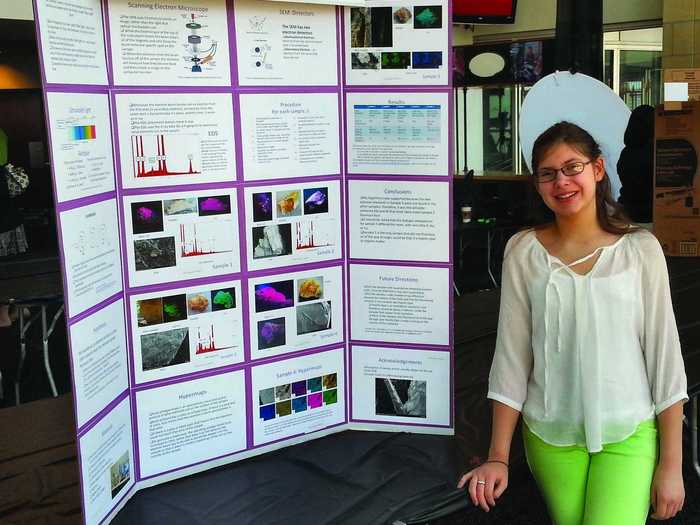
Emma Burnett, 12, wanted to know why feldspar — a rock-forming mineral — fluoresced different colors under ultraviolet light. Almost all the feldspar she observed in a North Carolina cave glowed pink, but one section glowed blue. Burnett found through her research that impurities, or small bits of other elements, that get mixed into a mineral deposit, can cause the same mineral to glow different colors.
Burnett used a powerful microscope called a spectroscope to examine samples of feldspar. The spectroscope revealed that iron and manganese were found in the pink-glowing feldspar, but molybdenum and tungsten showed up in the blue-glowing feldspar.
Burnett's future career interest is the following: plasma physics.
Elizabeth Corn discovered that the smaller the nanoparticle, the more effective it is at treating disease.
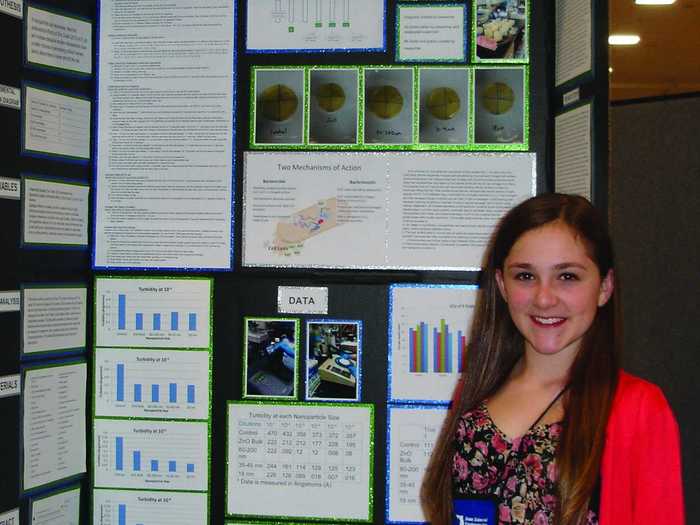
After reading about the medical benefits of nanotechnology, 14-year-old Elizabeth Corn wanted to test if smaller nanoparticles would be more effective than larger ones. She used zinc oxide particles ranging from 18 to 200 billionths of a meter, and tested their ability to kill a nonpathogenic strain of E. coli.
Corn found that the smaller nanoparticles were more effective at killing the E. coli bacteria than the larger particles.
Corn's future career interest is the following: neuroscience.
Keoni Gandall designed a plasmid to genetically alter microorganisms.
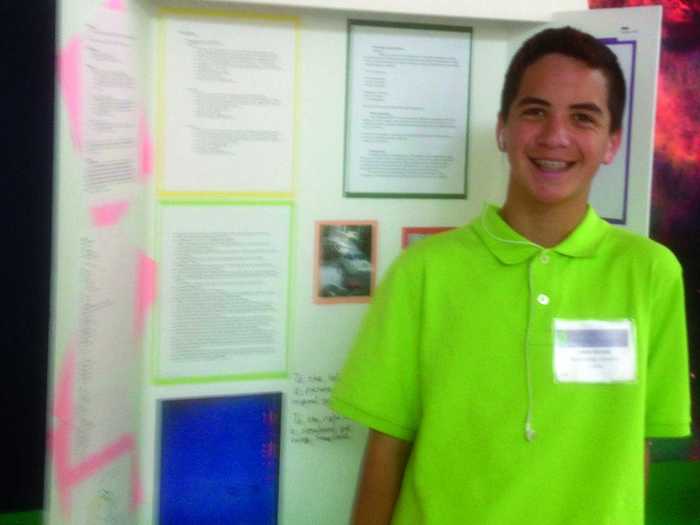
Keoni Gandall, 14, began experimenting with genetic engineering after learning about DNA in seventh grade. He started experimenting with Halobacteria — a saltwater microorganism that looks pink or red. Gandall wanted to make Halobacteria that glowed green.
In order to do this, Gandall had to create his own plasmid — a circle of DNA that includes the code for the green-glowing protein. Unfortunately, Gandall didn't have the resources to insert the plasmid into the bacteria to check that they glow green.
Gandall's future career interest is the following: medicine.
Mihir Garimella developed a way to digitally experience scents.
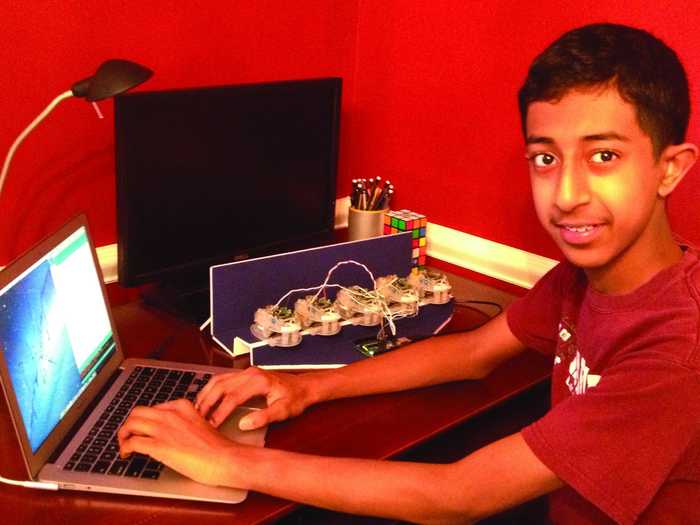
Mihir Garimella, 14, often travels to India to visit family and misses all the unique smells when he returns home. He noticed that computers can engage our sense of sight, hearing, and touch, but not smell. Garimella created a way to release different smells at specific moments during a short film.
By linking air fresheners containing microchips to a microprocessor, Garimella was able to create a digital library that releases scents at particular moments during the film. For example, cinnamon rolls on screen triggers the release of a cinnamon scent.
Garimella's future career interest is the following: robotic engineering.
Caleb A.T. Gonser studied competition for egg-laying among bean beetles.

Caleb Gonser, 13, studied the bean beetle — a common crop pest in parts of Africa and Asia. He previously studied whether female beetles preferred to lay their eggs on small or large beans. This time he wanted to find out if females prefer to lay eggs on beans that don't already have another female's eggs on them.
After several trials, Gonser found that females preferred to lay their eggs on the beans with fewer eggs, regardless of size. He also discovered that the female would lay more eggs on a bean that didn't already have other eggs on it. Avoiding competition with other female's eggs seemed to be the more important factor.
Gonser's future career interest is the following: physical therapy.
River C. Grace studied the rain dance behavior of the endangered radiated tortoises
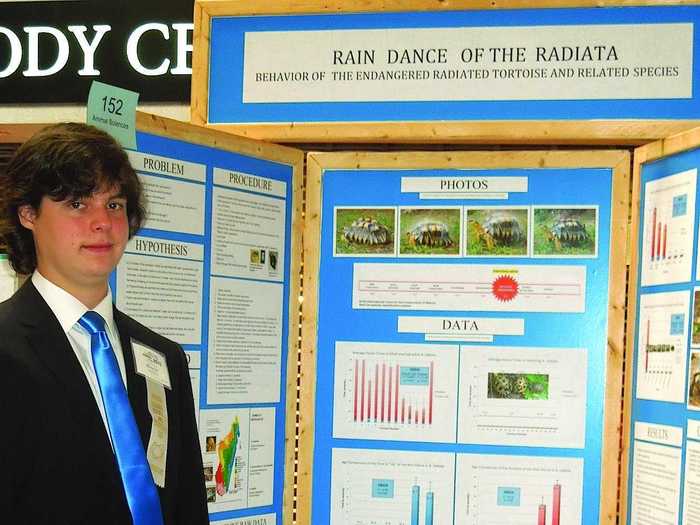
River Grace, 14, worked with a group of endangered radiated tortoises native to Madagascar. They rhythmically shuffle in a kind of "rain dance" when exposed to rain. Grace wanted to test if this behavior helped the tortoises avoid drowning in flash-floods.
In a series of experiments, Grace sprinkled the turtles with varied flows of water and measured how long before they began dancing and how long they danced. A light sprinkling was the control measurement, and that's when they danced the most. His results suggested that the dance isn't correlated to flood conditions.
Grace's future career interest is the following: physiology.
Seamus Hoolahan built and tested the efficiency of a Gauss rifle.
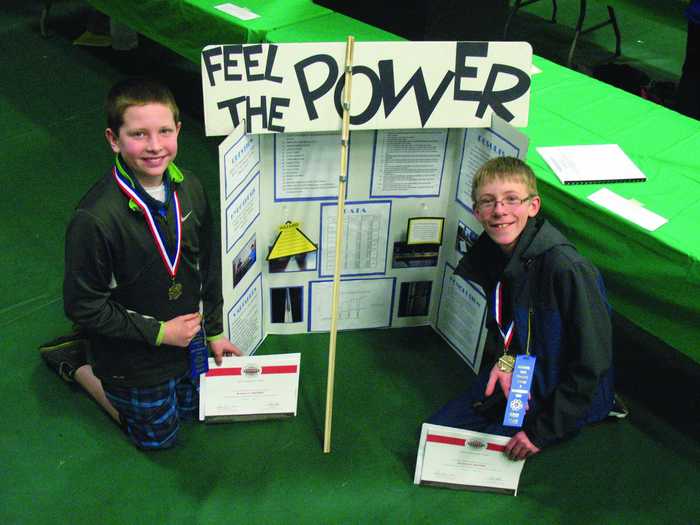
Seamus Hoolahan, 13, worked with a partner to build a Gauss rifle, which uses a magnetic chain reaction to launch a small steel ball. Hoolahan and his partner believed they could create a more efficient design of the rifle that could one day lead to the development of nonlethal magnetic guns.
The Gauss rifle relies on a series of magnets to launch the projectile. Hoolahan and his partner believed that fewer magnet pairs would launch the ball farther, but discovered that the opposite was true. More magnet pairs allowed more kinetic energy to build before the ball was launched.
Hoolahan's future career interest the following: chemical engineering.
Krystal Horton tracked the spread of an invasive species in San Diego.
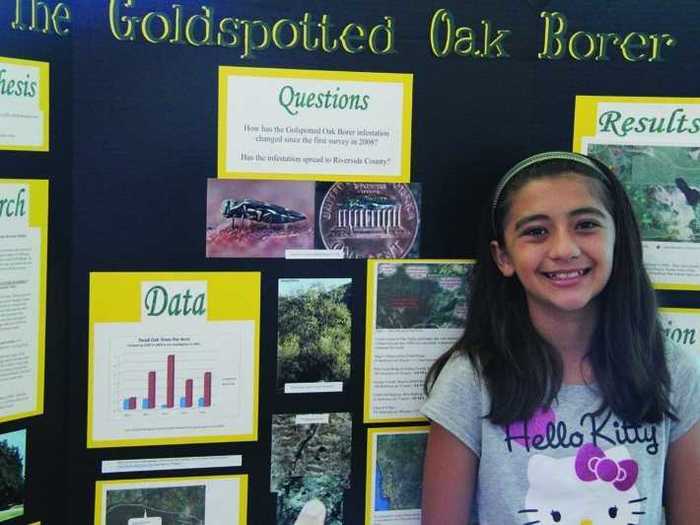
After reading about how the goldspotted oak borer has destroyed thousands of trees, 11-year-old Krystal Horton wanted to find a solution to the invasive pest. She learned how to identify infected trees, then visited areas surveyed in 2008 to determine if the problem had worsened.
After several months of surveying thousands of trees, Horton found that the number of infected trees per acre had increased significantly in every area. In some areas, a species of wasp keeps the goldspotted oak borer population in check, but her results suggest the wasp alone is not enough to control the infestation.
Horton's future career interest is the following: computer security specialist.
Dhruv Iyer used the rock-paper-scissors game as a model for human negotiation.
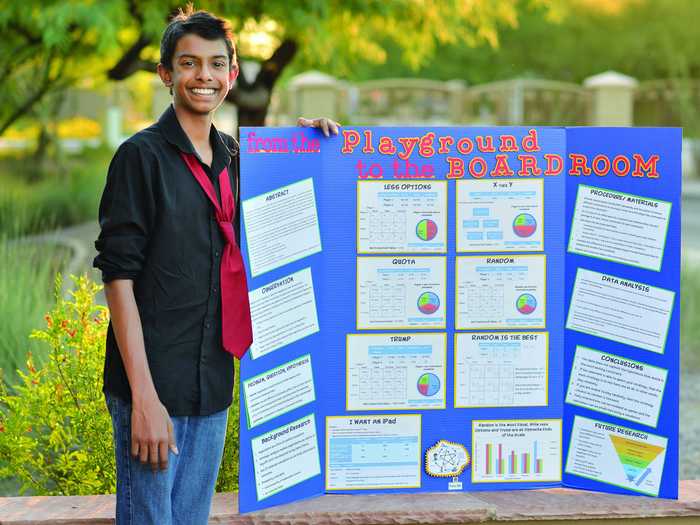
Dhruv Iyer, 15, designed his own computer simulation that would play 100 million games of rock-paper-scissors in just a few minutes. He wanted to test how putting constraints on one player would affect the outcome of the game, and to what extent the other player could exploit those constraints.
Iyer thought that requiring one player to use rock, paper, and scissors in a set ratio would be the most limiting. But that's not what he found. He saw that the best strategy was to have no strategy. The important take-away for Iyer from his experiment is that human negotiation can be modeled and predicted using a computer simulation.
Iyer's future career interest is the following: software engineering.
Cameron Jones used a balloon and coffee grounds to create a tool to grip and pick up objects.
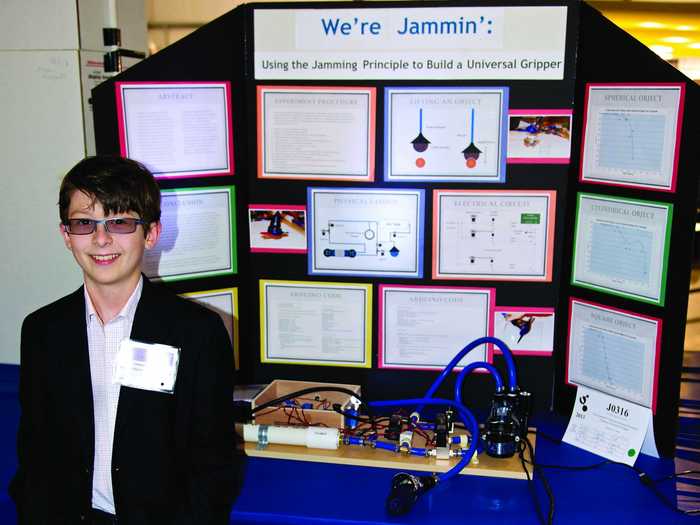
Robotic hands have a hard time gripping things; it requires complicated software and precise positioning. The "universal gripper" that 12-year-old Cameron Jones read about was a simple solution for this problem. Adding pressure to a plastic bag full of grainy material allowed the bag to wrap around an object, and applying a vacuum caused the grains to tighten around the object and effectively grip and pick it up.
Jones wanted to improve this gripper by creating his own computer-operated version. His device uses a latex balloon full of coffee grounds and can successfully pick up a ping pong ball, brass rod, and wooden block of various weights.
Jones' future career interest is the following: computer science.
Johann Kailey-Steiner found the optimal moment blades can be used to eliminate air resistance on rockets.
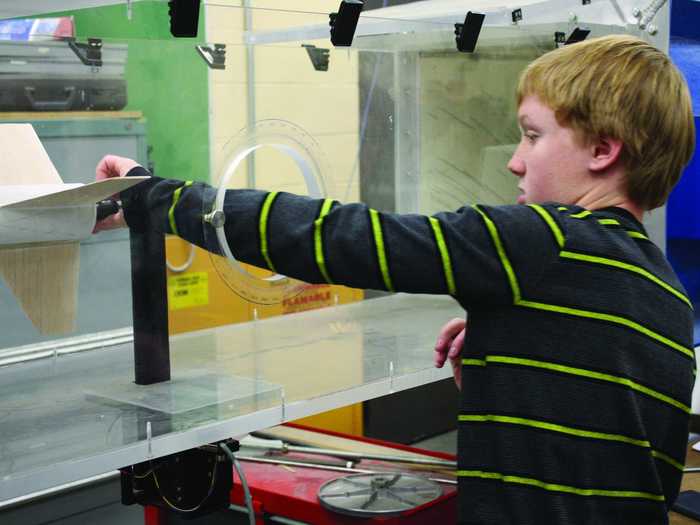
Johann Kailey-Steiner, 13, has previously experimented with vortex generators — blades that cut through air resistance and eliminate drag — on rockets. This time he wanted to find the moment at which extending the vortex generators would eliminate the most drag during a rocket's flight. Using a wind tunnel, Kailey-Steiner recorded drag on his rocket at various speeds, with and without vortex generators.
Initially he discovered the vortex generators were adding drag at every speed. He built another rocket and discovered that vortex generators could decrease drag if the rocket was angled slightly into the wind. This happens when the rocket engine cuts off, so that's when Kailey-Steiner designed his device to extend the vortex generators.
Kailey-Steiner's future career interest is the following: physics.
Rhea Kamat studied a molecule in broccoli that could accelerate lung growth.
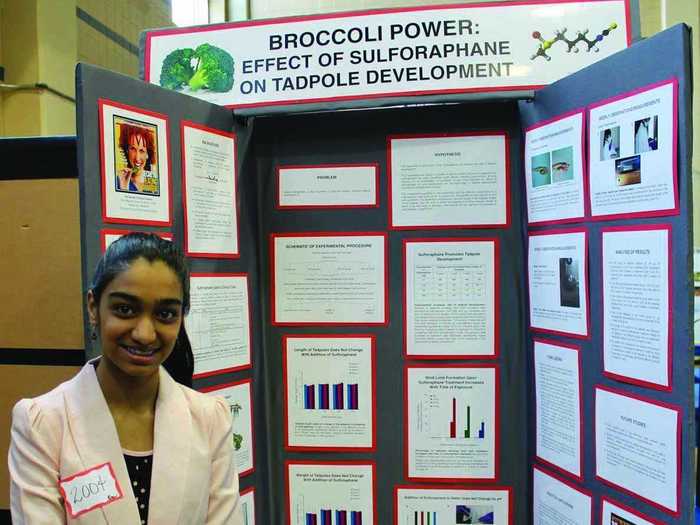
Rhea Kamat, 14, read about a molecule called sulforaphane found in broccoli. She learned that scientists were studying it as a possible treatment for lung diseases. Kamat wanted to test if sulforaphane could speed up lung development, with the hopes that it could be used to treat premature babies with underdeveloped lungs.
Kamat used tadpoles as the subject of her study. She could not directly study lung growth, so she examined hind leg growth because it happens around the same time. By the third week of her experiment, Kamat found that 22 to 56% of the tadpoles she had given sulforaphane to had started developing limbs, while the group that had not been given sulforaphane showed no signs of limb development.
Kamat's future career interest is the following: immunology.
Austin McCoy designed an inexpensive method to detect diseases in their early stages.

Austin McCoy, 13, designed a device to cheaply and easily detect dengue virus infection in its early stages. Catching the disease early on makes it much easier to prevent the spread. Diagnosing dengue usually involves a process called polymerase chain reaction, that makes millions of copies of the viral DNA.
Labs use an expensive machine to perform this process — not something you are likely to find in the third-world countries where dengue is prevalent. McCoy is automating the less expensive method of doing PCR by hand.
McCoy's future career interest is is the following: bioinformatics.
Smita Mohindra designed an noninvasive way to treat vertebrobasilar insufficiency.
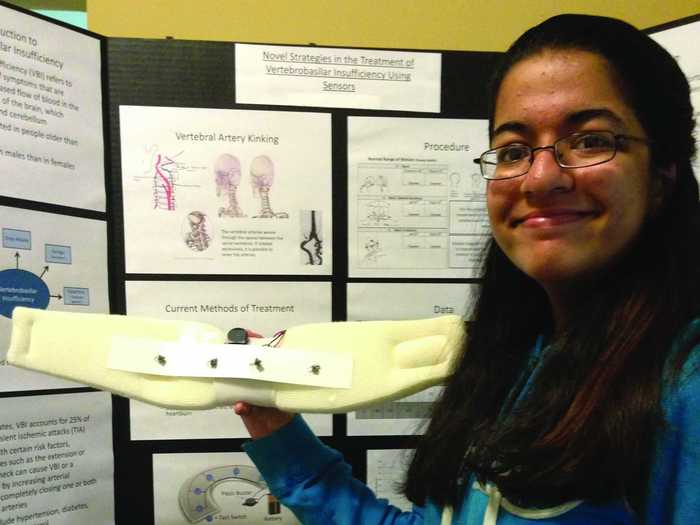
Smita Mohindra, 13, focused on vertebrobasilar insufficiency — a medical condition where not enough blood is getting to the back end of the brain. This is caused by excessive twisting or overstretching in the neck. Mohindra learned that most treatment options for this condition involved surgery or drugs, but she believed there could be a simpler solution.
Mohindra designed a soft neck collar with touch sensors that would warn the wearer when they were doing excessive stretching or twisting that could exasperate their condition. She hopes to test the device in high-risk patients.
Mohindra's future career interest is the following: biomedical engineering.
Caroline Nolan is helping honey bees thrive.
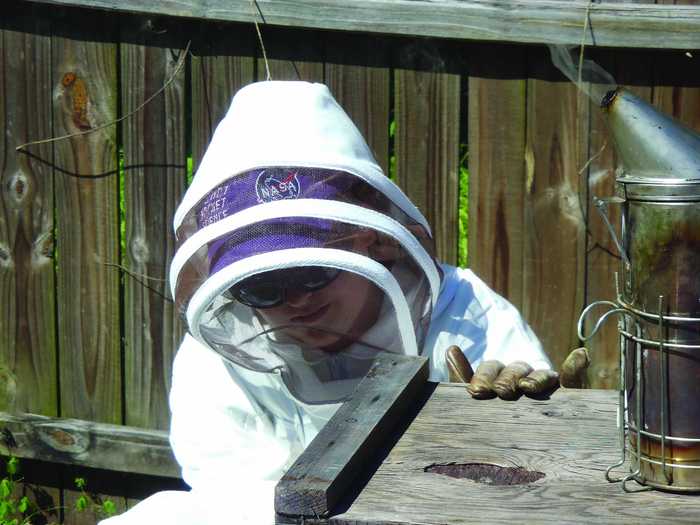
Caroline Nolan, 13, is concerned about the declining honey bee population and wanted to make their hives more efficient. She took a beekeeping class and built six beehives for her experiment.
Honey bees keep their hive cool by fluttering their wings. By cooling the hives externally, Nolan hoped to relieve the bees of that workload, hopefully making them healthier. Nolan discovered that the bees in the hives that had AC and solar ventilators collected more pollen and built larger hives than those that cooled their hives with their wings.
Nolan's future career interest is the following: piloting.
Julienne Sauer measured how much weight the magnetic field created by a superconductor can hold.
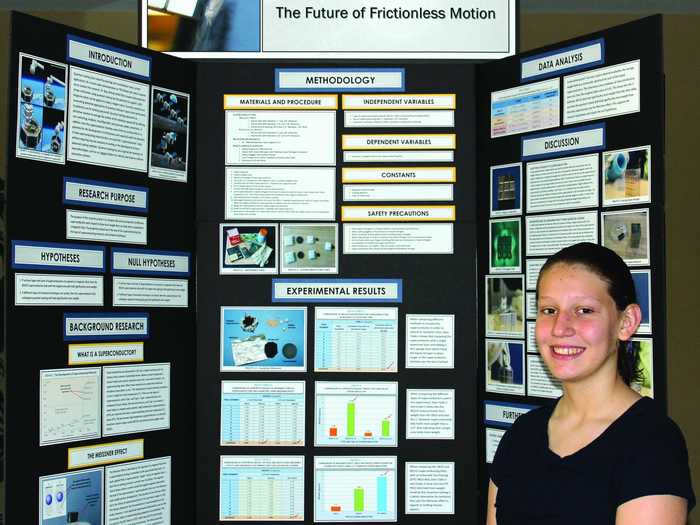
Julienne Sauer, 14, is interested in superconductors — metals that can make things levitate by creating a magnetic field when cooled to super-low temperatures. These superconductors are being used for frictionless motion; for example, trains that hover above their tracks.
But trains are really heavy, and weight becomes a problem when using superconductors. So, Sauer tested two different kinds of superconductor techniques to see which one could support the most weight. She found that the technique called quantum locking was the most effective.
Sauer's future career interest is the following: forensic anthropology.
Nathaniel Sperry investigated why some carrots turn green in carrot cakes.
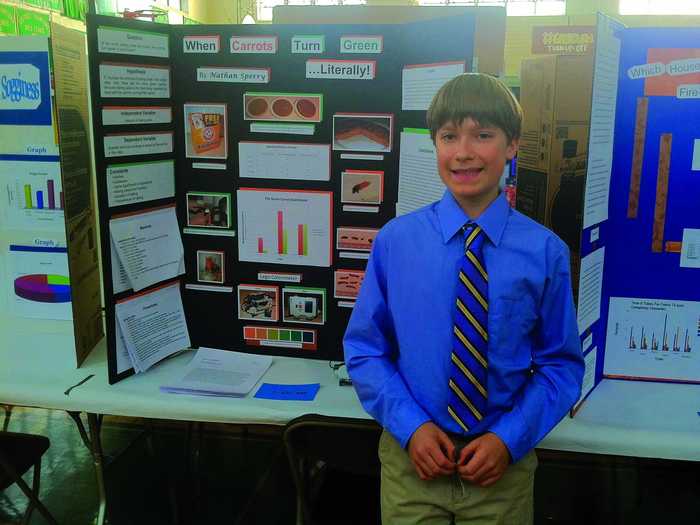
Carrot cakes are a tradition in 14-year-old Nathaniel Sperry's family, but over the years he noticed that sometimes after cutting into the cake, some of the carrots turned from orange to green. Sperry read that food bloggers identified baking soda as the ingredient that caused the color change.
Sperry found that cakes without baking soda had no green carrots, cakes with the typical amount of baking soda had a few green carrots, and surprisingly, cakes with twice the amount of baking soda also had no green carrots.
Sperry discovered that color compound called anthocyanin reacted to the basic pH level of baking soda. A slight basic pH caused anthocyanin to turn green, but an acidic pH or a really high basic pH turned it yellow or pinkish — similar to the orange color of carrots.
Sperry's future career interest is the following: computer programming.
Hannah Steele created a homemade magnetometer to measure solar flares.
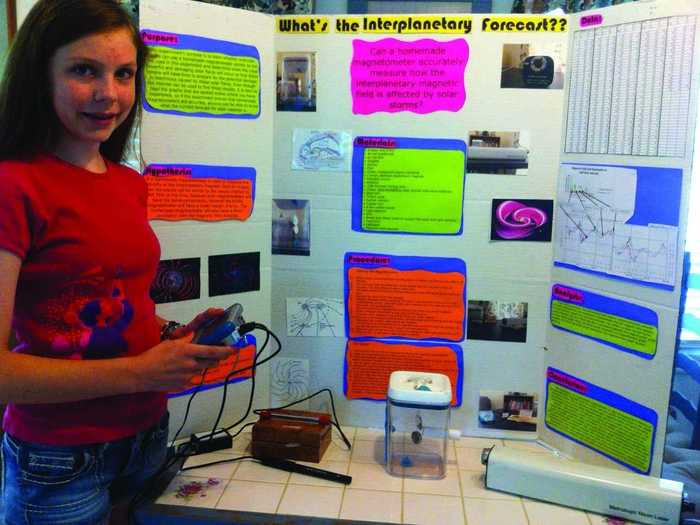
Hannah Steele, 13, made her own magnetometer — basically a powerful compass that detects the direction of magnetic fields from solar flares. She built hers using twin magnets, a laser, and a mirror.
She compared her homemade instrument to data collected from government instruments and found that her device could accurately measure solar flares.
Steele's future career interest is the following: chemistry.
Megan Swintosky discovered a new gene mutation linked to a lung condition.
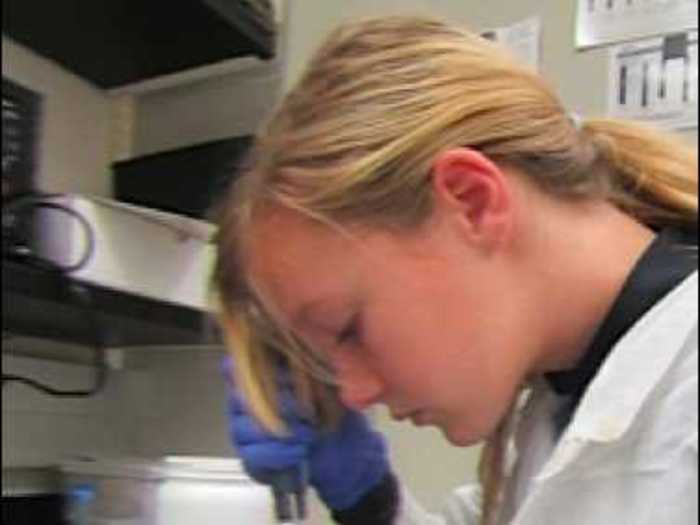
Several of 14-year-old Megan Swintowsky's family members suffer from spontaneous pneumothorax — a condition where air gets trapped between the lungs and chest cavity and can cause the lung to collapse. Swintowsky thought a shared genetic mutation might be the reason why so many of her family members are affected by the rare condition.
She collected DNA samples from her family across three generations and examined the folliculin gene since it had been linked to spontaneous pneumothorax in previous research. She sequenced the DNA of the folliculin gene in her family members and compared it to another sample from someone afflicted by the disease caused by a previously identified mutation.
She found that 17 of the 19 family members' genes contained a new mutation not expressed in the sample. A whole new mutation that also causes the disease.
Swintowsky's future career interest is the following: chemistry.
Brenna Wallin tracked radioactive waste from the Japanese power plant disaster to see if Pacific salmon were being contaminated.
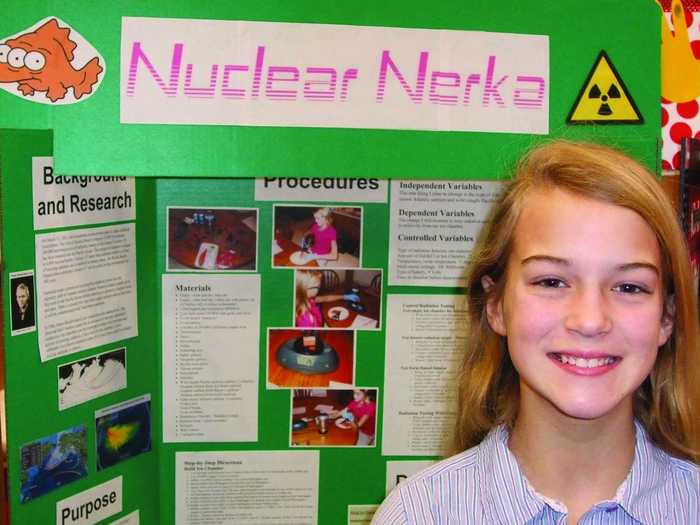
Brenna Wallin, 13, first researched where radiation from the Fukushima power plant intersected with migration routes of the salmon. She then built her own ion detector, using a coffee can and various other pieces, to see if Pacific sockeye salmon had higher than normal levels of ionic radiation.
She used Pacific salmon samples from Alaska and compared them to Atlantic salmon from Chile, Florida, and Scotland. Wallin found that the Pacific salmon did have higher levels of ionic radiation than the Atlantic salmon.
Wallin's future career interest is the following: neurology.
Sean Weber explored how shellfish adapt to harsh environments.
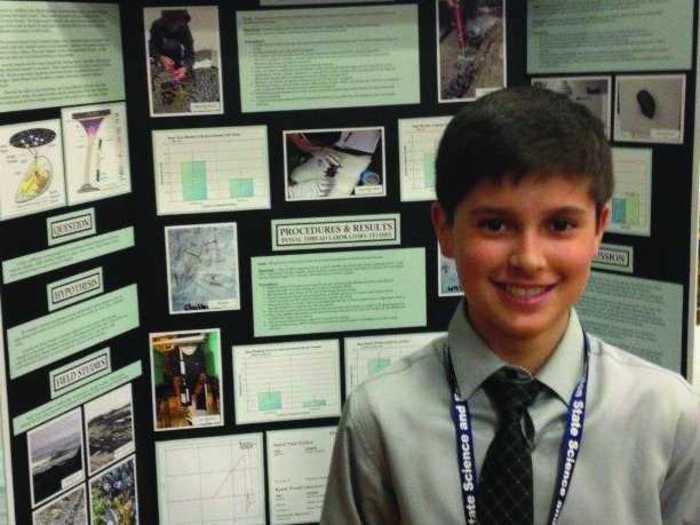
Sean Weber, 13, wanted to know if shellfish that attach themselves to rocks facing open water have different adaptations than shellfish that are attached to more sheltered areas. Shellfish rely on elastic material called byssal threads to cling to rock faces. Weber decided to measure the strength and number of byssal threads on the blue mussels near his home in Washington.
He compared the count and strength of byssal threads from mussels that faced the pounding waves and mussels that were attached in more covered areas. Weber found that it took 53% more force to dislodge the unsheltered mussels and those same mussels also had 50% more byssal strings.
Weber's future career interest is the following: neurology.
Joshua Wentzel built his own air cannon and tested how different variables affect a projectile's velocity.
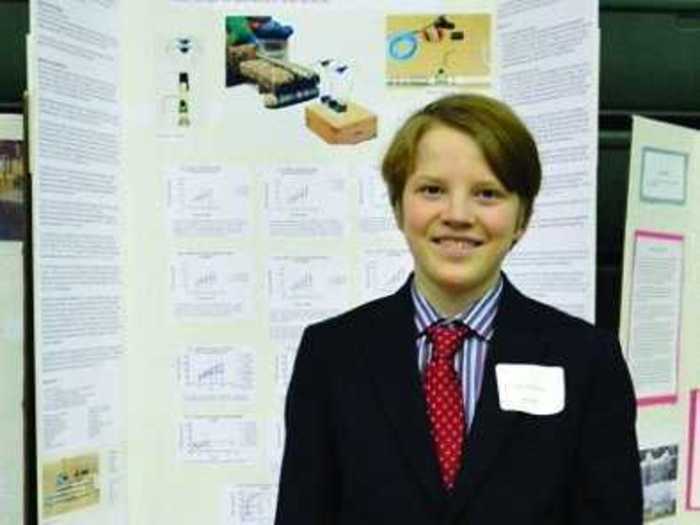
Joshua Wentzel, 14, built an air cannon to study how the volume and pressure of air used changes the velocity of its projectile — a golf ball. He also measured how the muzzle length impacts velocity.
Wentzel used a bike pump to create the pressure in his cannon and he used a chronograph — basically a stopwatch specifically designed to measure projectile velocity — to measure each launch. He found that increasing the pressure made the golf ball shoot out faster as long as the reservoir and barrel volume were the same.
Wentzel's future career interest is the following: mechanical engineering.
Grant Donovan Womble used the naturally aerodynamic shapes of several animals as a model for an efficient wind turbine.
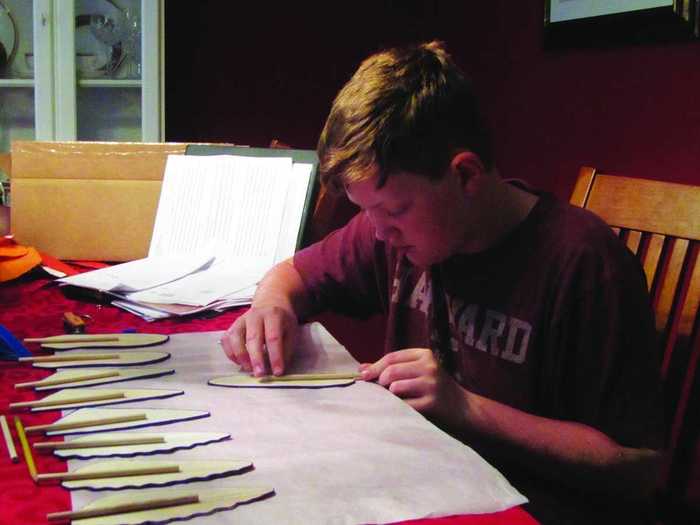
Biomimicry is the concept of taking something found in nature and using it as a model for pretty much anything. Grant Womble, 14, thought that wind-turbine blade designs based on the albatross, seagull, humpback whale, and flying fish might be more efficient than other blades, because these animals use their wings or fins to efficiently move through the air and water.
Womble built an electric circuit to measure the power that each turbine generated. Womble found that the blade modeled after a humpback whale's flipper made the most efficient wind turbine.
Womble's future career interest is the following: pediatric neurology.
Katherine Wu explored the relationship between schools that sold snacks/sweets and obesity rates of students at those schools.
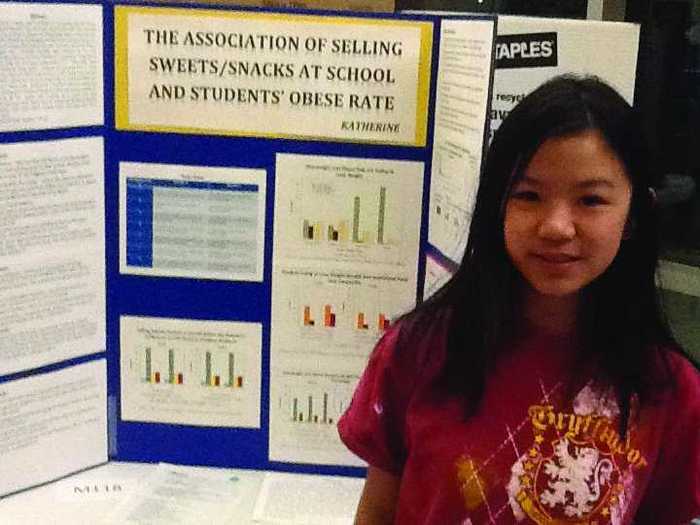
Katherine Wu, 13, tested the relationship between sweets and snacks sold at schools and their obesity rates. She used data from a federal survey of the age, height, weight, and snacking habits of 10,000 eighth graders. Then, she contacted the participants' schools to find out if they sold snacks and sweets.
Wu actually found no relationship between the school-sold snacks and obese children. Bans on non-nutritious food did not impact the obesity rate. Wu discovered that most obese students weren't buying snacks anyway.
Now check out the projects from the Google Science Fair.
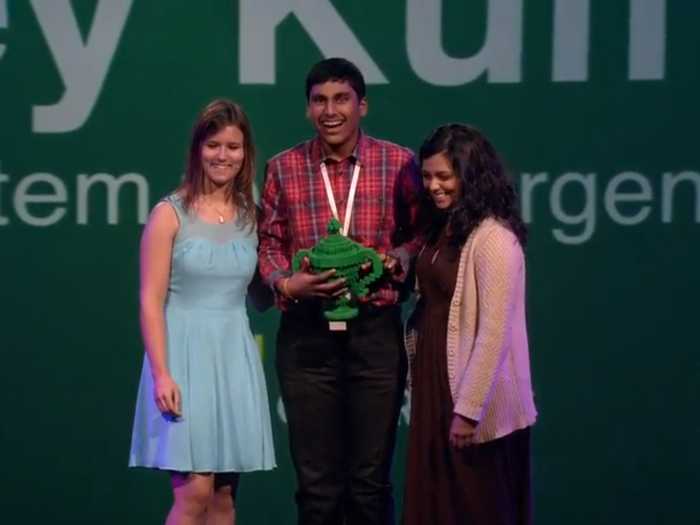
These 18 Teens Are Doing Amazing Things At The Google Science Fair »
Popular Right Now
Popular Keywords
Advertisement